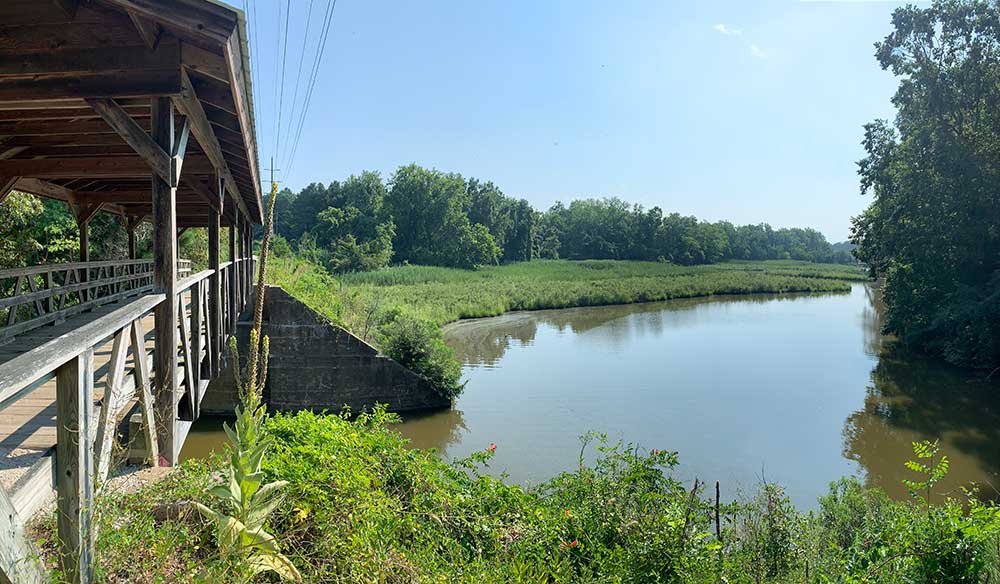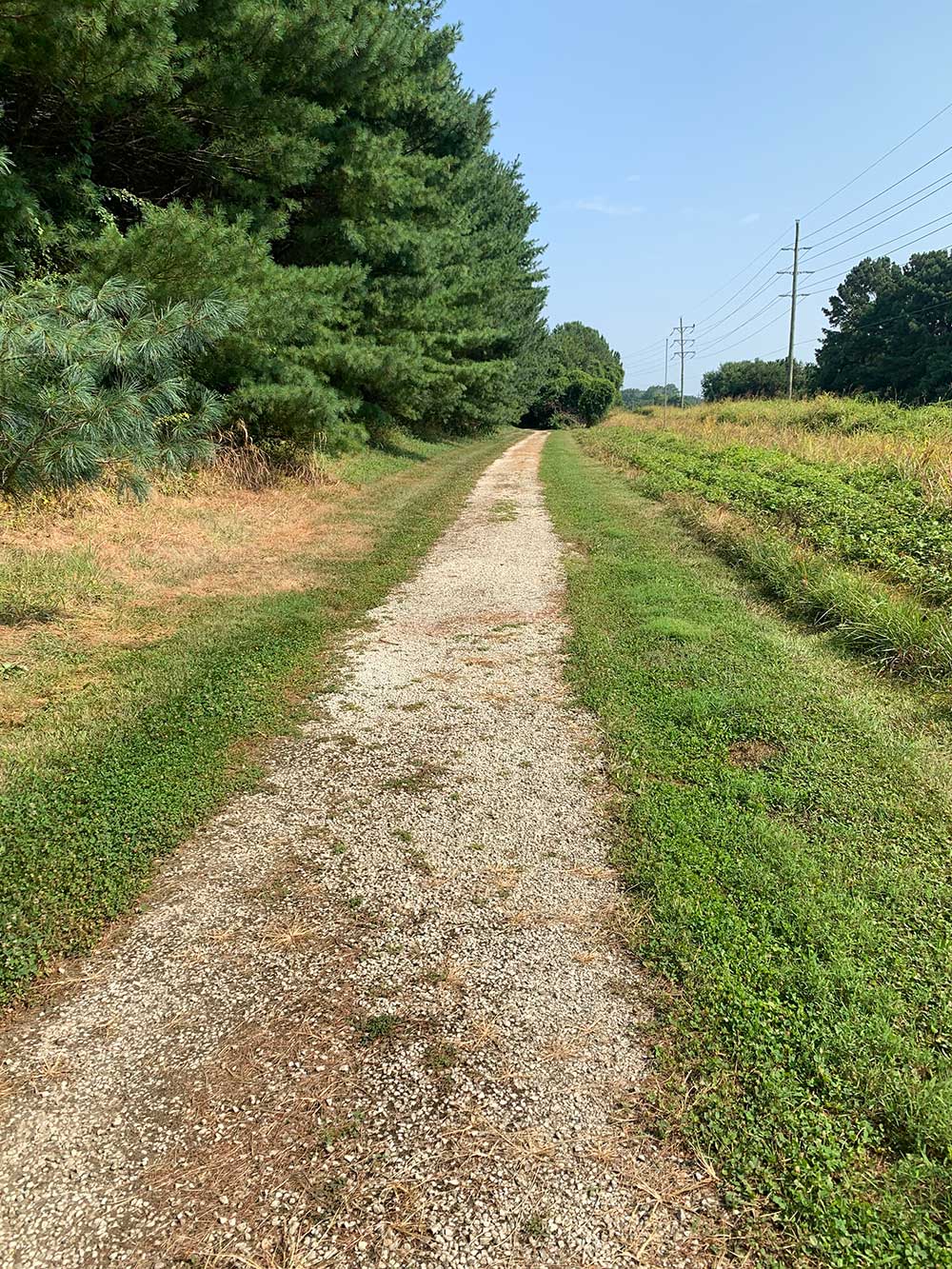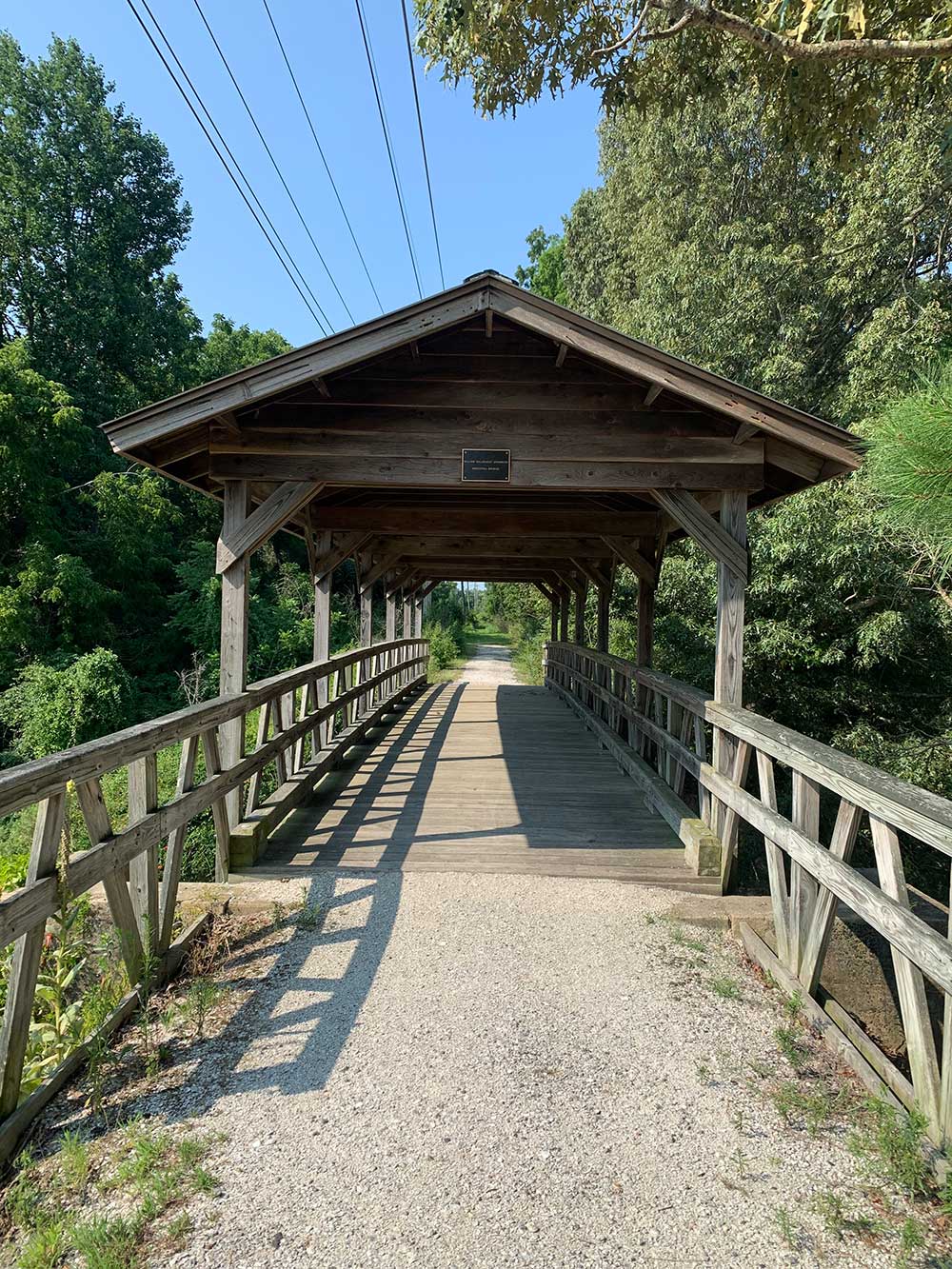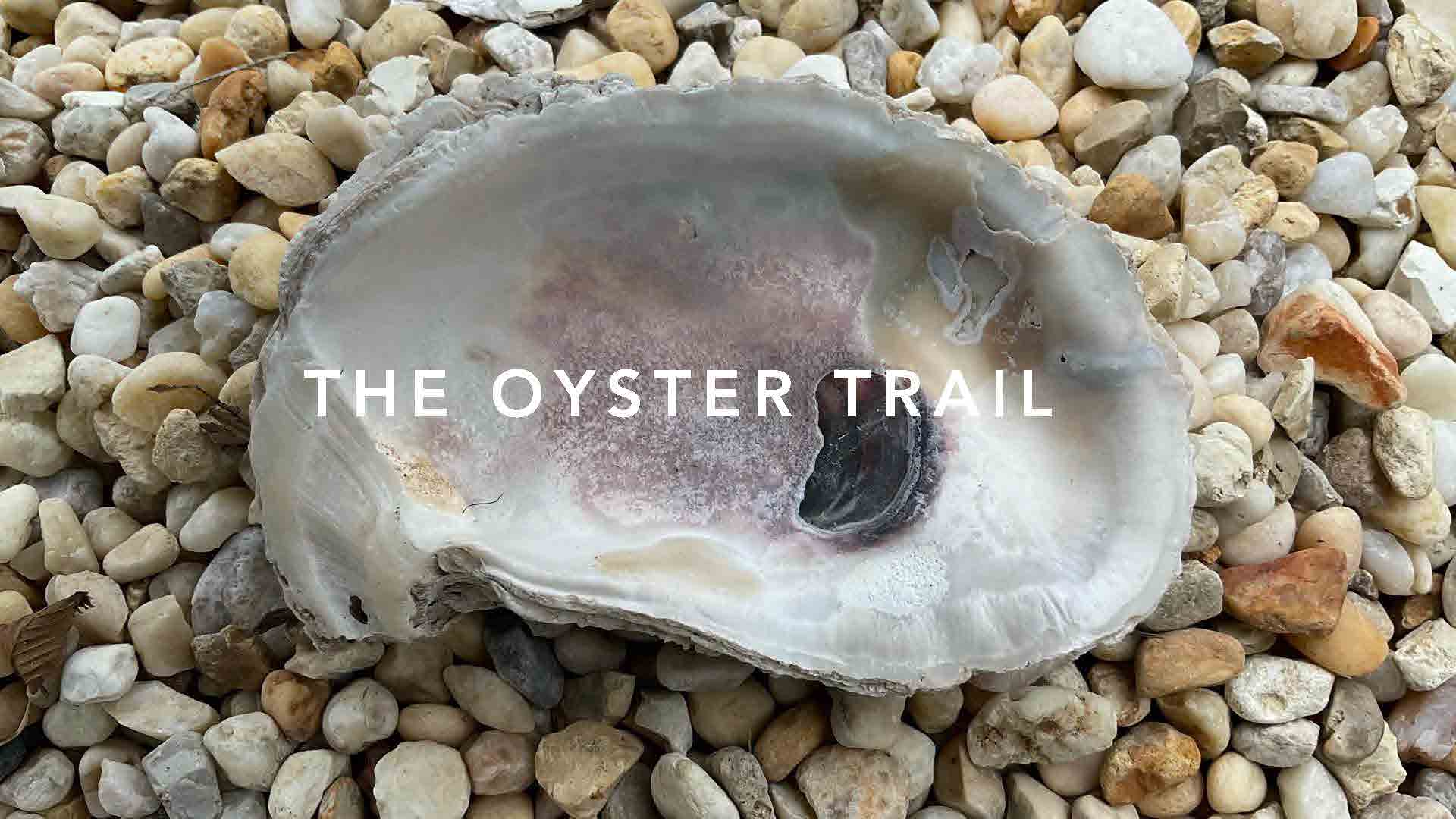First Steps
In late 2023, the Town of Oxford was approved for a Kim Lamphier Bikeways Grant for the initial feasibility and design of the first step of the proposed Oyster Trail – the Oxford Parks Connector Trail.
The grant is for a proposed shared-use recreational trail that will connect two parks in the Town of Oxford, MD with two adjacent County-owned parks. The project also includes study of installation of a bicycle service area. Ultimately, this project lays the foundation for creating an off-road route for people and families who ride bikes to enjoy the outdoors, especially the existing Oxford Conservation Park, and also supports the establishment of Oxford, MD as a terminus point in the future vision for a bicycle/pedestrian rail trail that connects Oxford to the Town of Easton. In alignment with our Comprehensive Plan and our Sustainable Community Plan, the Town of Oxford has been working with Talbot Thrive to improve the connectivity of our town parks and the County’s Oxford Conservation Park by developing a safe, accessible multi-use trail.
Who Was Kim Lamphier?
Kim Lamphier was a tireless supporter for safe, bicycle access across Maryland.
Over the years, Kim worked on issues relating to small businesses, bicycle safety, wildlife protection, criminal justice reform and promoting youth participation in government. She worked on the campaigns of some of Maryland’s luminary political figures at all levels of government. In her last year, 2019, in her roles with Trash Free Maryland and Bike Maryland, she was the principal advocate for two major legislative victories – the first statewide Styrofoam ban in the country and a bill that guarantees funding for Maryland’s Bikeways Network program. She worked to secure these victories, even as she was recovering from three months of intensive chemotherapy treatment and post-surgery physical therapy. She was an indomitable force.
In 2020, the Maryland General Assembly voted to rename the MDOT Bikeways Program in Kim’s honor.
The Dream: A Trail from Oxford to Easton – The Oyster Trail
¿Se imagina convertir la antigua servidumbre ferroviaria de Maryland y Delaware que va de Easton a Oxford en un sendero para peatones y ciclistas? Una exploración reciente realizada por un miembro de la junta ha descubierto que la ruta es parcialmente visible en varios lugares a lo largo de Oxford Road y ha sido parcialmente mantenida por propietarios privados desde el cierre de la línea ferroviaria en 1996. Un parque/camino lineal podría servir para conectar los servicios comerciales, históricos y culturales a lo largo de un sendero de uso compartido para peatones, corredores y ciclistas de todas las edades y niveles de forma física.
Terminado tras la Guerra Civil, el Oxford Spur fue una pieza clave de la infraestructura que condujo a la prosperidad de la región de Eastern Shore Tidewater. La servidumbre de 66 pies de ancho se abandonó a mediados de los años sesenta y el terreno se traspasó a los propietarios adyacentes. El reto consistirá en encontrar la manera de recuperar el acceso a una parte de la antigua servidumbre y las investigaciones preliminares indican que será difícil, pero no insuperable. La organización Rails to Trails Conservancy de Washington DC ha sido de gran ayuda para muchos otros grupos que han llevado a cabo con éxito proyectos similares en otros lugares. Hay más de 2.000 ejemplos de proyectos ferroviarios de éxito en los 50 estados, así que hay muchos buenos precedentes que seguir. La recientemente aprobada Ley de Infraestructuras contiene importantes fondos para proyectos de transporte activo como éste.
Imagínese que, en un futuro próximo, será posible recorrer toda la ruta de 8 millas que va de Oxford a Easton por una vía verde arbolada, segura y hermosa, que ayudaría a sostener el comercio local y atraería a peatones y ciclistas a una amenidad saludable y segura tanto para los visitantes como para los residentes locales del condado de Talbot.
Gracias al miembro del Consejo Cameron J. Mactavish de Oxford MD
El sueño...
CONVERTIR EL FERROCARRIL HISTÓRICO DE OXFORD EN UNA SENDA PEATONAL Y CICLISTA
Aunque el último tren circuló antes de 1960, muchos tramos del antiguo ferrocarril de Oxford y Easton siguen existiendo y son transitables a pie hasta nuestros días.
SALUD Y SEGURIDAD DE RESIDENTES Y VISITANTES
Un carril exclusivo para peatones y ciclistas mejorará la salud y la seguridad de los residentes y visitantes del condado de Talbot al sacarles del arcén.
de la cada vez más transitada Oxford Road
AUGE PARA LAS EMPRESAS LOCALES
El aumento del tráfico de peatones y ciclistas permitirá a las empresas locales prosperar durante todo el año. Se han llevado a cabo más de 2.000 proyectos en los 50 estados y el impacto económico positivo de estos proyectos está bien documentado.
CONEXIÓN CON EL POSIBLE CARRIL BICI DE ST. MICHAEL'S RD CARRIL BICI
La conversión de este tramo y la creación de un enlace con el carril bici de Easton creará un "Oyster Loop" de 40 km que conectará Oxford, Easton y St Michael's y se extenderá hasta McDaniel. El transbordador de Oxford puede utilizarse para completar el bucle.

Frequently Asked Questions
¿Tener un sendero no perjudicará el valor de mi propiedad?
Los estudios realizados después de que los senderos hayan estado en funcionamiento durante varios años indican sistemáticamente que (los senderos) eran mejores vecinos de lo que esperaban los escépticos. Cuando se comparan con el statu quo, algunos perciben los senderos acondicionados como un lastre que probablemente reducirá su calidad de vida. Sin embargo, con el tiempo es probable que surjan dos escenarios que hagan que el negativismo se disipe. En primer lugar, la experiencia confirma a los residentes próximos que sus temores eran infundados o exagerados. En segundo lugar, dado que la proximidad a un sendero es relativamente escasa en muchas comunidades urbanas, es probable que quienes lo consideren un equipamiento deseable paguen un precio superior por las propiedades cuando se pongan a la venta. (Compton, 2019)
Artículos y estudios
- Impacto de las vías verdes en el valor de la propiedad
- Ventas de Viviendas Cerca de Two Massachusetts Rail Trails
- Opciones públicas y valor de la propiedad
- Carriles bici: seguridad y valor de la propiedad
- El carril bici Mohawk-Hudson: su impacto en las propiedades residenciales colindantes
- El impacto de la ruta escénica del Pequeño Miami en los valores de las propiedades residenciales unifamiliares
- Impacto de las vías férreas en el valor de la propiedad- Estudio de caso del carril bici Minuteman
- Senderos recreativos de Omaha: su efecto en el valor de la propiedad y la seguridad pública
- Resumen del estudio de impacto comunitario de Pinellas County Trail
¿Cómo puede funcionar con seguridad un sendero de uso compartido dentro de una zona agrícola activa?
Los senderos y las zonas agrícolas activas pueden convivir en armonía, como demuestran los ejemplos de todo Estados Unidos, que incluyen una amplia gama de niveles de uso, superficies de senderos y políticas de gestión. Las siguientes estrategias han sido esenciales para el éxito de los senderos en zonas agrícolas:
- Vallado natural y físico para delimitar claramente el sendero y las zonas agrícolas y proporcionar barreras
- Posibilidad de que los agricultores coloquen notificaciones en el sendero cuando las operaciones agrícolas se verían limitadas o serían peligrosas para los usuarios del sendero.
- Cruces controlados que permitan a la maquinaria agrícola llegar a ambos lados del sendero, cuando sea necesario.
- Señalización para alertar a los usuarios del sendero de la presencia de explotaciones agrícolas activas e instrucciones para que los usuarios permanezcan en el sendero (dado que el sendero seguirá siendo propiedad del Estado, los terratenientes cuyas propiedades linden con el sendero no serán responsables de las actividades de quienes abandonen la propiedad del Estado e invadan terrenos de propiedad privada).
- Crear grupos o clubes de defensa que velen por el mantenimiento y la observación del sendero para minimizar el vandalismo y fomentar un entorno de autovigilancia.
Artículos:
¿Un sendero no traerá delincuencia y vagabundos a mi propiedad?
Numerosos estudios han demostrado que el desarrollo de proyectos ferrocarril-carril no conlleva un aumento de la delincuencia. La National Rails to Trails Coalition estudió en 1996 el impacto de tres grandes proyectos de este tipo y descubrió que la incidencia de delitos en las vías era muy baja en comparación con los índices generales de delincuencia. Su sitio web estudiar de senderos rurales concluido:
- Se calcula que hay unos 26 millones de usuarios anuales en los 254 senderos rurales encuestados, que cubren 8.000 km.
- La tasa nacional de atracos en zonas rurales es de 19 por cada 100.000 habitantes; ninguna de las rutas ferroviarias rurales denunció atracos en 1995 y sólo una denunció un incidente en 1996.
- La tasa nacional de agresiones con agravantes en el medio rural es de 203 incidentes por cada 100.000 personas; sólo tres vías rurales registraron tres agresiones en 1995 y el mismo número en 1996.
- A nivel nacional, se produjeron 26 violaciones forzadas por cada 100.000 habitantes rurales; dos senderos rurales denunciaron violaciones en 1995 y un sendero denunció una violación en 1996.
- La tasa nacional de asesinatos en zonas rurales es de 5 por 100.000; ninguna de las rutas ferroviarias rurales registró un asesinato en el periodo de dos años.
Artículos y estudios
- Vías férreas y comunidades seguras
- Efectos de los senderos en los barrios, el valor de la vivienda, la seguridad y la calidad de vida
- ¿Deben preocuparse por la delincuencia los vecinos próximos a carriles bici?
- Evaluación del efecto del Camino Burke-Gilman sobre los valores de la propiedad y la delincuencia
- El carril bici Mohawk-Hudson: su impacto en las propiedades residenciales colindantes
¿Cómo pueden coexistir de forma segura las actividades cinegéticas con un sendero de uso compartido cercano?
Hay más de 22.000 millas de senderos ferroviarios en EE.UU. y, como puede imaginarse, muchos de ellos atraviesan zonas rurales donde la caza es una parte importante de la comunidad. Los gestores de senderos (algunos pueden ser superintendentes de bosques estatales o nacionales) han aportado distintas soluciones a los conflictos que pueden surgir en los senderos debido a la caza. De hecho, las pruebas históricas de la compatibilidad entre los senderos y la caza están muy arraigadas en los senderos de una sola vía, como el Sendero de los Apalaches. Uno de los senderos ferroviarios más antiguos del país, el Stony Creek Railroad Grade, de 20 millas, en el condado de Dauphin, Pensilvania, atraviesa más de 40.000 acres de terrenos de caza estatales y lleva en funcionamiento desde 1943 sin que se conozca ningún accidente.
Algunos ejemplos de otros senderos ferroviarios que se han establecido adyacentes o a través de terrenos de caza públicos y privados y terrenos de caza privados y que han acomodado con éxito a los usuarios de los senderos y a los cazadores.
Artículos
- Clarion, PA - Little Toby Creek Rail-Trail y West Penn Rail-Trail (El Clarion-Little Toby Creek Trail y el West Penn Trail exigen que los usuarios de los senderos lleven el color naranja durante la temporada de caza).
- Área natural de Springvalley (Xenia, OH) Un sendero multiusos para bicicletas discurre a lo largo de una de las marismas más cazadas del estado. Karen Kelley, directora del distrito de parques del condado de Marion, reconoce la importancia del sendero para preservar el hábitat de la fauna salvaje, "Nuestro distrito de parques va a intentar mostrar a través del railtrail las marismas y las praderas de tallgrass en temporada para apoyar esos esfuerzos por preservar y mantener el hábitat de la fauna".
- Buffer de no caza: Algunos senderos que atraviesan terrenos de caza públicos y privados imponen un "buffer de no caza" (Amherst, MA) Está prohibido llevar armas de fuego cargadas a menos de 150 pies del sendero, lo que se corresponde con la ley estatal de Massachusetts relativa a la caza cerca de carreteras pavimentadas. Sin embargo, los cazadores utilizan a menudo la vía férrea para ir y volver de los lugares de caza.
- Vía Verde del Valle del Genesee
(Oeste de Nueva York) En este sendero multiusos de 90 millas, los cazadores pueden utilizar el sendero para acceder a los lugares de caza, pero no pueden disparar desde o a través del sendero. El sendero no está cerrado durante la temporada de caza, y uno de los propietarios adyacentes es un club de caza. - Resumen de la normativa de caza de Maryland
- En Guía completa de caza y pesca en Maryland estados:
- Es ilegal disparar al blanco en terrenos estatales excepto en las zonas designadas. (Las vías férreas son terrenos estatales)
- Es ilegal cazar, disparar o atrapar animales salvajes a menos de 150 yardas de cualquier edificio o campamento ocupado por seres humanos sin permiso del propietario u ocupante.
Mi propiedad está junto al corredor ferroviario. Cómo puedo beneficiarme de la vía férrea y cómo va a aportar la vía desarrollo económico a esta zona?
La forma en que los propietarios de tierras a lo largo del corredor ferroviario se beneficien de la vía férrea a través de oportunidades de negocio depende de ellos y de su espíritu empresarial. Los funcionarios de Desarrollo Económico del condado de Talbot trabajarán activamente con quienes manifiesten su interés por una aventura empresarial para maximizar esa oportunidad y su éxito. Además, los funcionarios de planificación y zonificación del condado se han comprometido a garantizar la zonificación adecuada a lo largo del corredor ferroviario para apoyar cualquier propuesta de negocio que surja. El agroturismo y los senderos en general pueden ser un importante motor económico para toda la zona, especialmente con el aumento de visitantes que se espera del parque Frederick Douglass en el río Tuckahoe.
Artículos y estudios
- Bring Business: Guía para atraer cicloturistas a las comunidades neoyorquinas del Canal
- El Parque Histórico Nacional del Canal de C&O es un motor económico para las comunidades circundantes
- Convertir los corredores ferroviarios en motores económicos
- Impacto económico de la ruta ferroviaria de Shanendoah
"La reconversión de los antiguos derechos de paso del ferrocarril en sistemas de senderos dinámicos requiere planificación, compromiso comunitario, asociaciones de colaboración y mejores prácticas innovadoras combinadas con un enfoque de equidad e inclusión. Los resultados son sistemas de ferrocarril a sendero que ofrecen una variedad de opciones de vivienda asequible, promueven oportunidades económicas y de transporte, y mejoran la calidad de vida de todos los residentes."
Las fotos de abajo son de una excursión reciente en busca del antiguo lecho del ferrocarril a lo largo del corredor de Oxford. Por favor, no invadir la propiedad privada.




